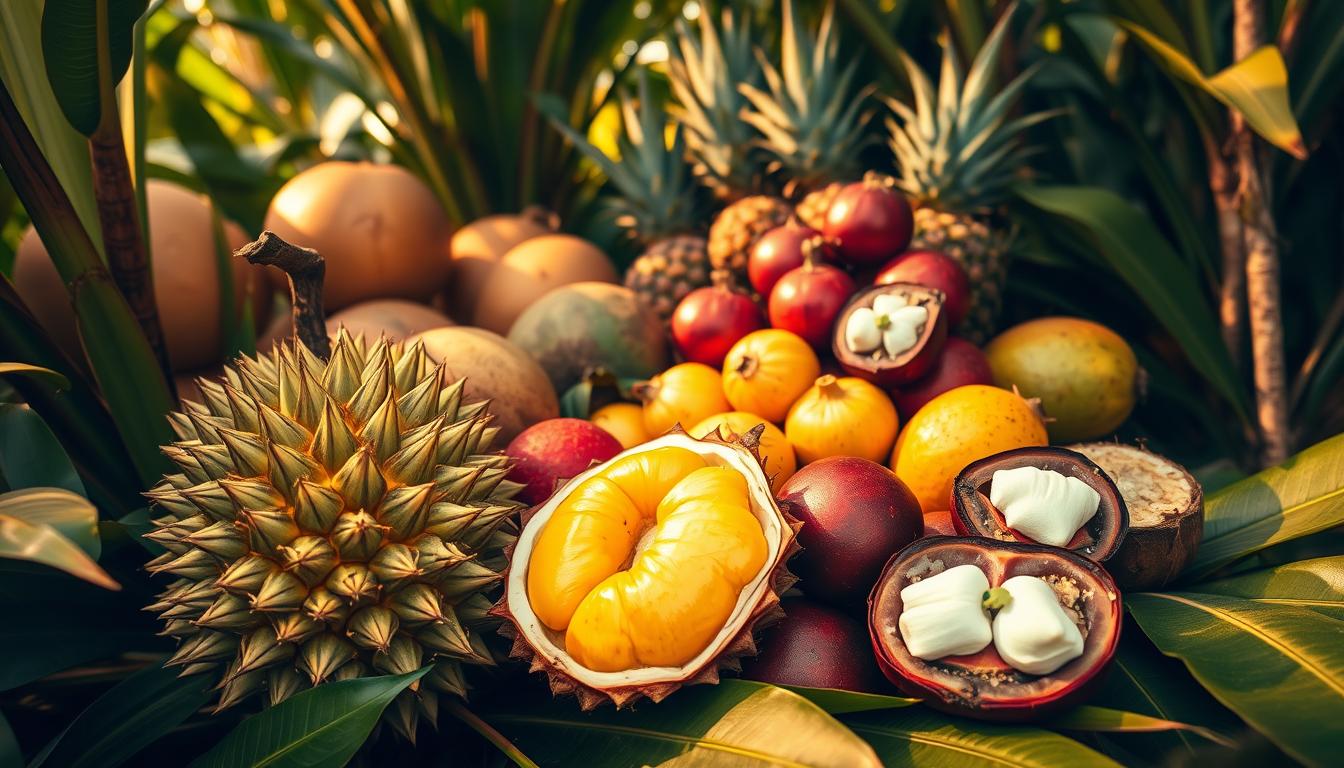Thai Fruits Guide: Seasonal & Exotic Flavours
Did you know Thailand has over 50 types of tropical fruits? Many are not just tasty but also full of nutrients.
Thailand is a fruit lover’s dream, with a wide range of exotic tastes that vary with the seasons. This guide will show you the different tropical fruits in Thailand. You’ll learn about their special qualities and how to enjoy them.
Discover the rich variety of Thailand’s tropical fruits. Find out how to get the most from their health benefits and delicious flavours.
Introduction to Thai Fruits
Thai fruits are a world of exotic tastes and health perks. They are not just tasty but also full of nutrients. These fruits can improve your health in many ways.
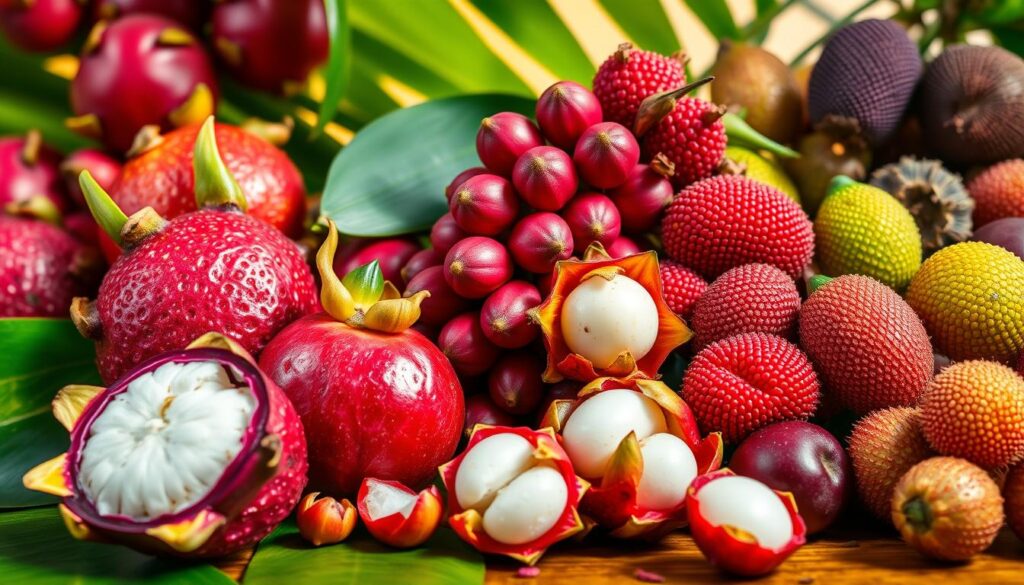
Why You Should Explore Thai Fruits
Trying Thai fruits is a fun journey of new tastes and textures. You’ll find everything from sweet mangoes to unique durians. These fruits are also full of vitamins, minerals, and antioxidants, making them great for a healthy diet.
The variety of Thai fruits means there’s something for everyone. Whether you want a quick snack or a healthy boost, you’ll find it here.
Health Benefits of Eating Fruits
Eating different fruits, like those from Thailand, has many health benefits. Fruits are full of antioxidants, which protect cells and lower disease risks. They also have lots of fibre, vitamins, and minerals, helping with digestion, immune function, and overall health.
- Boosts immune system
- Supports healthy digestion
- Rich in antioxidants
- Provides essential vitamins and minerals
Seasonal Thai Fruits You Must Try
Thailand’s fruit scene is a kaleidoscope of colours and flavours, changing with the seasons. You can experience the best of Thai fruits by understanding what’s in season.
Exploring the Seasonal Fruit Calendar is a great way to discover new flavours. Each season brings its unique offerings, ensuring that there’s always something exciting to try.
March to May: Tropical Delights
During these months, the tropical heat brings forth a variety of delicious fruits. You can enjoy:
- Mangoes at their peak ripeness and sweetness
- Durians, known for their distinctive flavour and texture
- Rambutans, with their hairy exterior and sweet pulp

June to August: Rainy Season Picks
The rainy season might dampen outdoor activities, but it’s a great time to indulge in some of Thailand’s juiciest fruits. You should try:
- Mangosteens, often referred to as the “Queen of Fruits”
- Longans, known for their sweet and fragrant flesh
- Water apples, refreshing and hydrating
September to November: Harvest Time
As the weather cools down, the harvest season brings a new wave of fruits. You can look forward to:
- Pomelos, a larger relative of the grapefruit, sweet and tangy
- Langsat, a fruit with a unique flavour, often eaten fresh
- Santol, a lesser-known fruit with a sweet and slightly sour taste
Understanding the seasonal availability of these fruits can enhance your fruit-eating experience. You can enjoy the freshest produce and explore the diverse flavours that Thailand has to offer.
Exotic Fruits to Discover in Thailand
Start a food adventure in Thailand with its exotic fruits. Each fruit has a unique taste and texture. You’ll want to try them all.
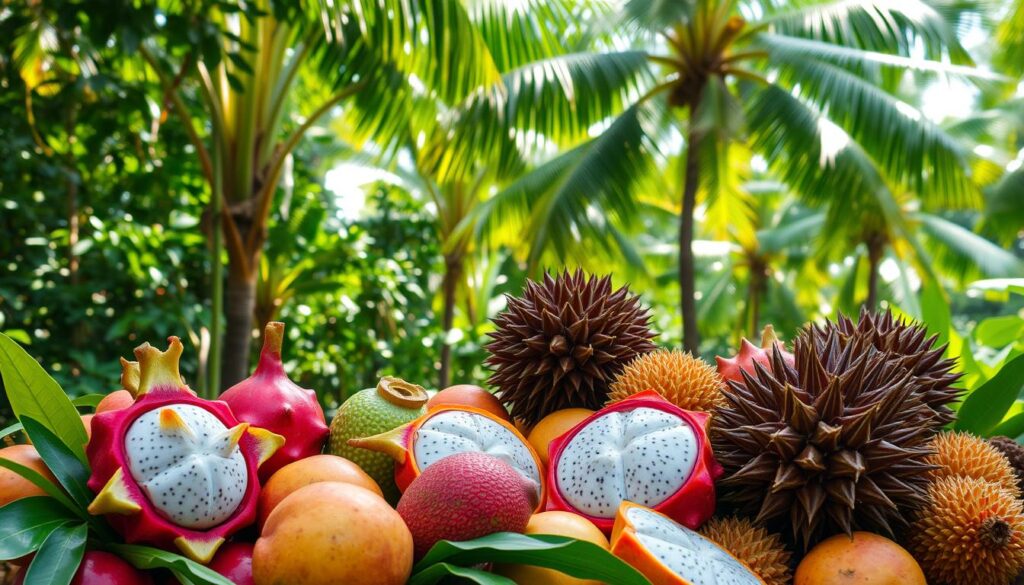
Durian: The King of Fruits
Durian is famous for its creamy texture and strong smell. Some love it, others don’t. But, it’s a must-try in Thailand.
Durian is packed with nutrients like vitamins and healthy fats. You can enjoy it fresh, dried, or in desserts. It’s a unique taste experience.
Mangosteen: The Queen of Fruits
Mangosteen is loved in Thailand for its soft white inside and sweet taste. Its purple rind is soft when ripe. It’s easy to pick the best one.
Mangosteen is full of antioxidants and is good for you. It’s not just tasty but also healthy.
Rambutan: A Bubbling Gem
Rambutan looks funny with its hairy skin and tastes sweet and a bit sour. Its name means “hairy” in Malay. It’s fun to eat.
Rambutan is rich in vitamin C and manganese. Its look and taste make it a favorite in Thailand. You should try it.
How to Choose the Perfect Thai Fruit
Choosing the perfect Thai fruit is a fun experience with the right tips. Knowing what to look for is key to enjoying their unique tastes and textures.
Tips for Selecting Fresh Fruits
To pick the best Thai fruits, look for freshness signs. Check for bright colors, firmness, and a nice smell. For example, a ripe mango should smell sweet, and a durian should feel creamy.
Here are some general tips for selecting fresh Thai fruits:
- Look for vibrant colors and avoid fruits with bruises or blemishes.
- Check the aroma; a ripe fruit should have a pleasant, fruity smell.
- Feel the texture; for example, a ripe mango will be slightly soft to the touch.
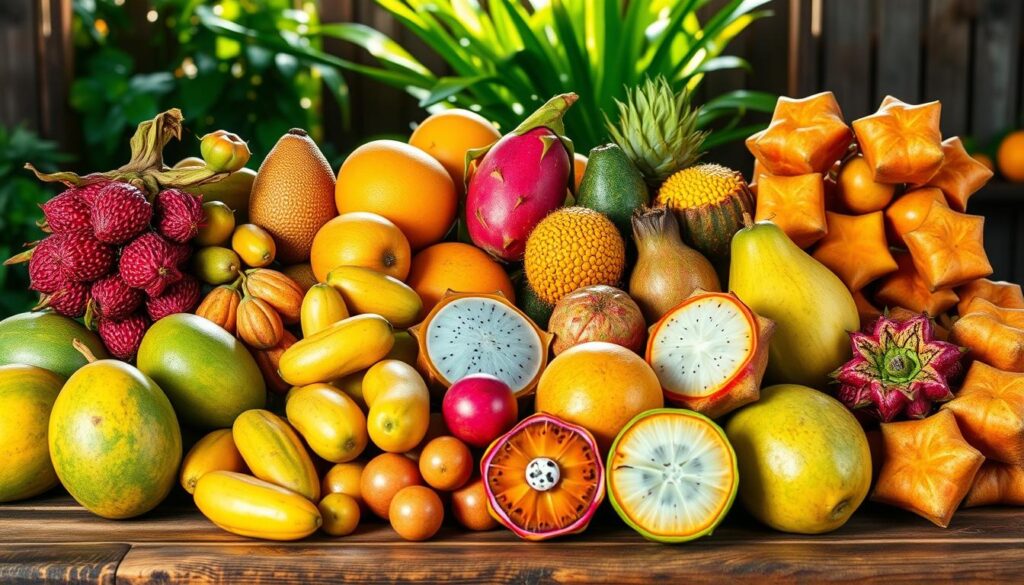
Understanding Ripeness Indicators
Knowing when a Thai fruit is ripe is essential. Different fruits show ripeness in different ways. For instance, a ripe banana is yellow with brown spots, and a jackfruit has a strong, sweet smell when ready.
Here are some specific ripeness indicators for popular Thai fruits:
- For mangoes, a sweet aroma and a slight softening of the skin indicate ripeness.
- Durian is ripe when it has a creamy, custard-like flesh.
- Rambutan will be red or yellow when ripe, depending on the variety, and will have a sweet, slightly acidic taste.
By following these tips, you’ll enjoy Thai fruits at their best. This will make your fruit-eating experience even better.
Traditional Thai Desserts Featuring Fruits
In Thai cuisine, fruits are key in desserts, turning simple ingredients into works of art. You can taste the rich flavours and textures of Thai fruits in many traditional desserts. These desserts are both tasty and beautiful to look at.
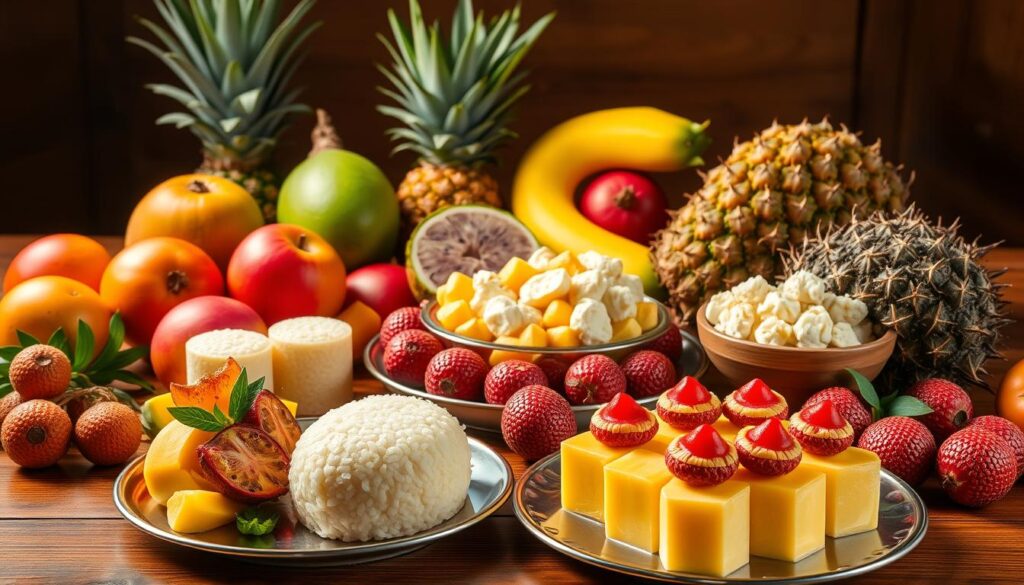
Sticky Rice with Mango
Sticky rice with mango is a favourite Thai dessert. It combines the sweetness of ripe mangoes with creamy coconut milk-infused sticky rice. The secret to this dessert is using perfectly ripe mangoes and freshly cooked sticky rice, which absorbs the coconut milk perfectly.
Coconut Custard with Pumpkins
Coconut custard with pumpkins is another dessert that shows off Thai fruits and ingredients. The soft flesh of pumpkins is filled with a rich coconut custard. This dessert is not only tasty but also looks great, making it a hit at Thai gatherings.
Fruit Salads: A Thai Classic
Fruit salads are a refreshing and popular Thai dessert. They often include mango, durian, and jackfruit. The beauty of a Thai fruit salad is its mix of sweet, sour, and creamy flavours, giving a balanced taste. You can pick your favourite fruits to make these salads, making them a flexible dessert choice.
Trying these traditional Thai desserts with fruits gives you a peek into Thai culinary traditions. You can find these desserts at local markets, restaurants, or even make them at home with fresh Thai fruits.
The Role of Fruits in Thai Cuisine
Thai fruits are a big deal in savoury dishes, making them taste amazing. They help balance out the flavours in traditional recipes. This balance includes sweet, sour, salty, and spicy.
Savoury Delights
Thai fruits add a special touch to many dishes. For example, mangoes and pineapples are used in salads and curries. They bring a sweet and tangy taste that contrasts with spicy and sour flavours.
- Mangoes are used in spicy sour salads, such as som tam, to balance out the heat.
- Pineapples are added to curries, like massaman curry, to introduce a sweet and fruity flavour.
- Tamarind is used to add a sour flavour to dishes like pad thai.
Unique Fruit Pairings and Flavours
Thai cuisine is famous for its creative fruit pairings. These pairings create complex and interesting flavours. Here are a few examples:
- The combination of durian and coconut milk in rich and creamy desserts.
- The pairing of mangosteen with sticky rice, giving a sweet and slightly sour taste.
- The use of rambutan in fruit salads, adding a sweet and slightly acidic flavour.
These unique pairings show how versatile Thai fruits are. They can make a wide range of dishes, from savoury curries to sweet desserts, taste better.
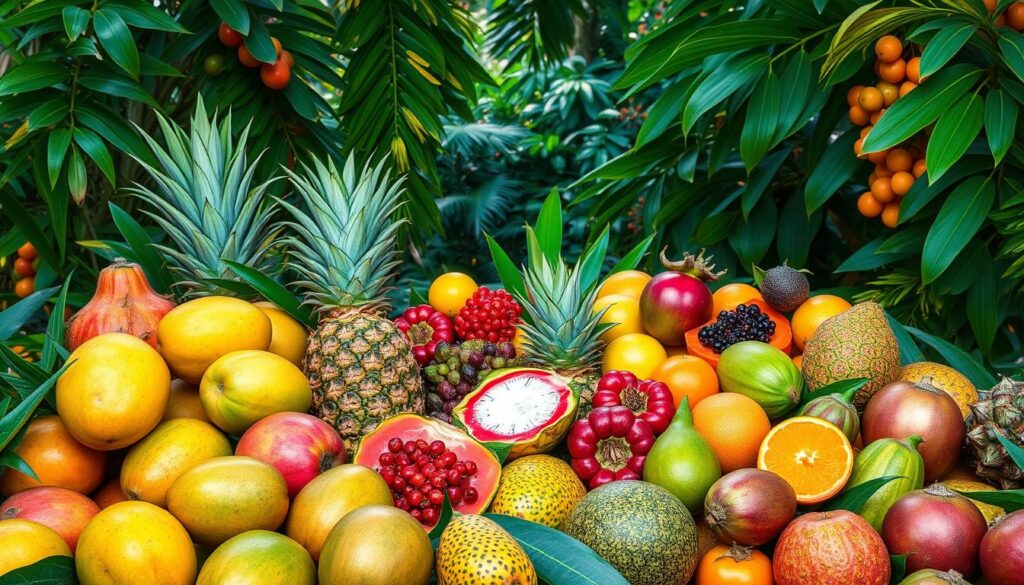
Popular Thai Fruit Markets in Thailand
Exploring Thailand’s local markets is a must for fruit lovers. These markets are filled with a wide range of fruits. You’ll find everything from seasonal treats to exotic finds, making for a memorable experience.
Bangkok’s Chatuchak Market
Bangkok’s Chatuchak Weekend Market is huge and famous worldwide. Walking through the stalls, you’ll find amazing seasonal fruits Thailand has to offer. Look out for durian, mangosteen, and rambutan.
- A vast array of fruits, both local and exotic
- Opportunities to taste fruits before purchasing
- A vibrant atmosphere that showcases Thai culture
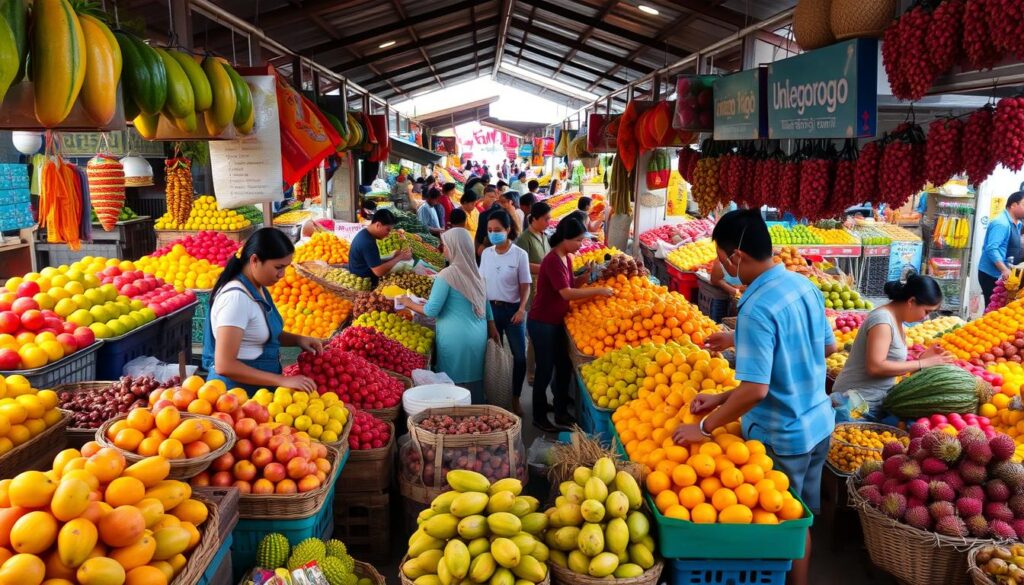
Chiang Mai’s Local Markets
Chiang Mai’s markets are a paradise for fruit lovers. The night bazaar and walking streets have a wide variety of fruits at good prices. Here, you can try local favourites and discover Chiang Mai’s unique flavours.
- Visit the night bazaar for a wide selection of fruits
- Explore the walking streets for local fruit varieties
- Engage with local vendors to learn about the fruits
Visiting these markets lets you experience Thailand’s rich fruit variety. It also gives you a glimpse into local culture and daily life. Whether you’re in Bangkok or Chiang Mai, the Thai fruit markets are a must-see for fruit enthusiasts.
Growing Your Own Thai Fruits in the UK
You can grow exotic fruits from Thailand in the UK if you know the right climate. Thailand’s warm weather is different from the UK’s, but some Thai fruits can grow well in greenhouses. With the right planning and conditions, you can have Thai fruits in your UK garden.
Optimal Environmental Conditions
Thai fruits need warm, humid weather to grow. In the UK, you must protect your plants from cold winters and keep them warm when it’s growing season.
Key climate considerations include:
- Keep the temperature between 15°C to 30°C for most Thai fruits.
- Ensure humidity is over 60% to match the tropical climate.
- Keep plants away from frost, as most Thai fruits can’t handle freezing.
Suitable Varieties for the UK Climate
Not all Thai fruits grow well in the UK, but some do. Here are a few good choices:
- Rambutan: This fruit grows well in greenhouses or large containers moved indoors in winter.
- Mangosteen: Though hard to grow, mangosteen thrives in a humid, controlled environment.
- Durian: Some dwarf durian varieties can grow in big pots and be moved indoors in cold months.

By understanding and creating the right climate and choosing the right fruits, you can grow your own Thai fruits in the UK. It’s a fun and rewarding hobby that brings a taste of Thailand to your garden.
Conclusion: Embracing the Thai Fruit Experience
Exploring Thai fruits is a unique culinary adventure. You’ll find everything from the creamy durian to the tangy mangosteen. These fruits can make your meals and desserts even more special.
Practical Tips for a Thai Fruit Lifestyle
Start by trying new recipes with Thai fruits. Visit Asian markets for fresh fruits. If you can, grow your own Thai fruits in the UK.
Experiment with different pairings. Mango with sticky rice or coconut custard with fresh fruit are great options. This way, you can discover new tastes.
Discovering the Cultural Significance
Thai fruits are more than just food; they’re part of Thai culture. By trying them, you connect with Thailand’s rich heritage. Use this Thai Fruits Guide to start your journey into the world of Thai fruits.

